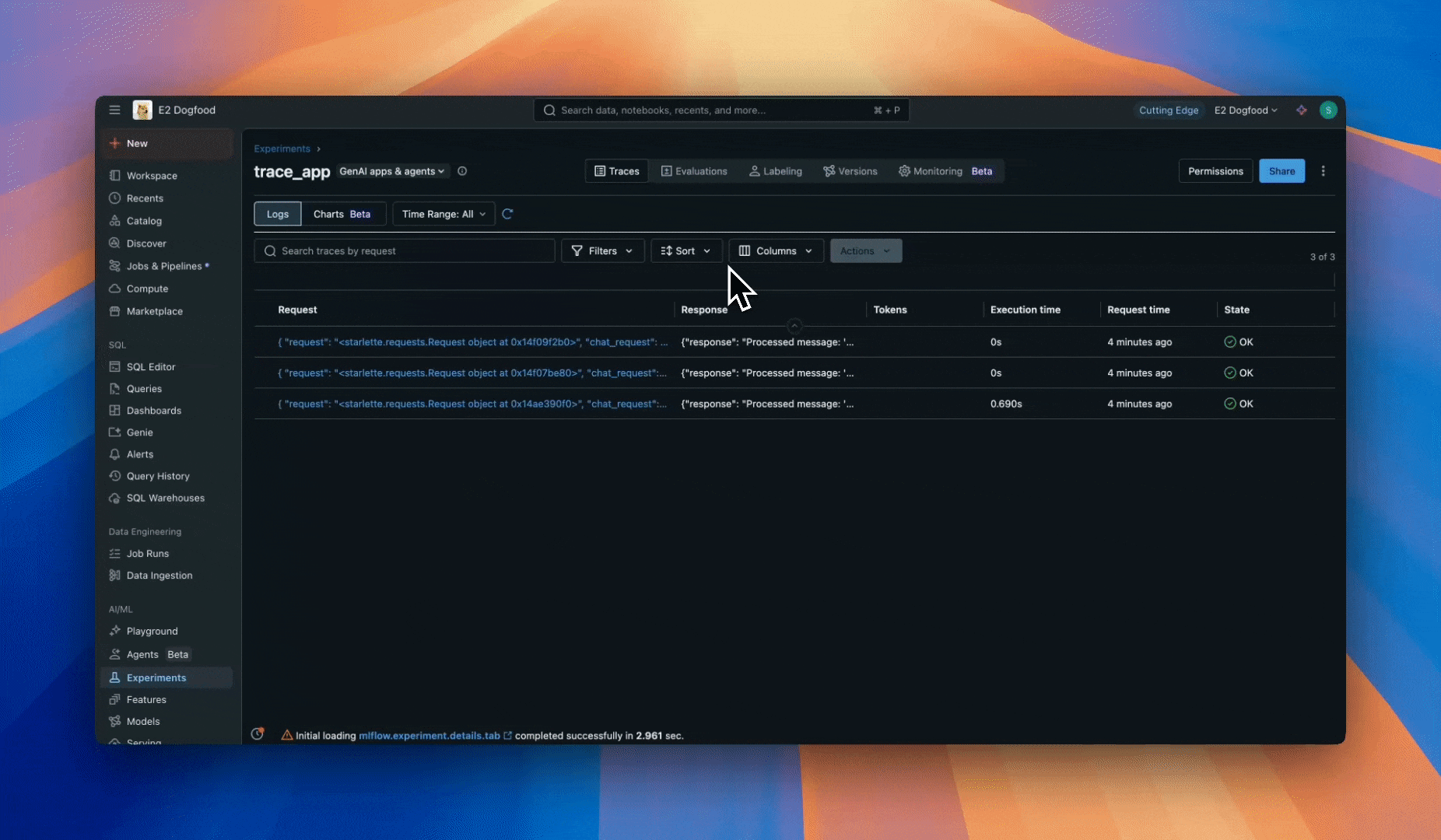Nota:
El acceso a esta página requiere autorización. Puede intentar iniciar sesión o cambiar directorios.
El acceso a esta página requiere autorización. Puede intentar cambiar los directorios.
MLflow 跟踪允许生产应用使用其他元数据和上下文(例如请求 ID、会话和用户 ID 以及自定义标记)来增强跟踪。 应用还可以记录用户反馈以及跟踪。 然后,可以使用此元数据来组织、分析和调试跟踪。
将元数据添加到跟踪
基本跟踪工作后,将元数据或上下文添加到跟踪,以便更好地调试和见解。 生产应用程序需要同时跟踪多个上下文片段:用于调试的客户端请求 ID、用于多轮次对话的会话 ID、用于个性化和分析的用户 ID,以及用于作见解的环境元数据。 MLflow 具有以下标准化标记和属性,用于捕获重要的上下文信息:
| Metadata | 用例 | MLflow 属性或标记 |
|---|---|---|
| 客户端请求 ID | 将跟踪链接到用于端到端调试的特定客户端请求或 API 调用 |
TraceInfo 参数 client_request_id |
| 用户会话 ID | 从多轮次对话对跟踪进行分组,使你能够分析完整的聊天流 |
mlflow.trace.session 标记 |
| 用户 ID | 将跟踪与特定用户相关联,以便进行个性化、队列分析和用户特定的调试 |
mlflow.trace.user 标记 |
| 环境数据 | 跟踪部署上下文(环境、版本、区域),以便跨不同部署进行作见解和调试 | 自动标记 和 常见自定义标记 |
| 自定义标记 | 添加自定义元数据,尤其是用于组织、搜索和筛选跟踪 | (标记) |
下面是一个全面示例,演示如何跟踪 FastAPI 应用程序中的所有这些内容。
import mlflow
import os
from fastapi import FastAPI, Request, HTTPException # HTTPException might be needed depending on full app logic
from pydantic import BaseModel
# Initialize FastAPI app
app = FastAPI()
class ChatRequest(BaseModel):
message: str
@mlflow.trace # Ensure @mlflow.trace is the outermost decorator
@app.post("/chat") # FastAPI decorator should be inner decorator
def handle_chat(request: Request, chat_request: ChatRequest):
# Retrieve all context from request headers
client_request_id = request.headers.get("X-Request-ID")
session_id = request.headers.get("X-Session-ID")
user_id = request.headers.get("X-User-ID")
# Update the current trace with all context and environment metadata
# The @mlflow.trace decorator ensures an active trace is available
mlflow.update_current_trace(
client_request_id=client_request_id,
metadata={
# Session context - groups traces from multi-turn conversations
"mlflow.trace.session": session_id,
# User context - associates traces with specific users
"mlflow.trace.user": user_id,
# Override automatically populated environment metadata
"mlflow.source.type": os.getenv("APP_ENVIRONMENT", "development"), # Override default LOCAL/NOTEBOOK
# Add customer environment metadata
"environment": "production",
"app_version": os.getenv("APP_VERSION", "1.0.0"),
"deployment_id": os.getenv("DEPLOYMENT_ID", "unknown"),
"region": os.getenv("REGION", "us-east-1"),
# Add custom tags
"my_custom_tag": "custom tag value",
}
)
# --- Your application logic for processing the chat message ---
# For example, calling a language model with context
# response_text = my_llm_call(
# message=chat_request.message,
# session_id=session_id,
# user_id=user_id
# )
response_text = f"Processed message: '{chat_request.message}'"
# --- End of application logic ---
# Return response
return {
"response": response_text
}
# To run this example (requires uvicorn and fastapi):
# uvicorn your_file_name:app --reload
#
# Example curl request with context headers:
# curl -X POST "http://127.0.0.1:8000/chat" \
# -H "Content-Type: application/json" \
# -H "X-Request-ID: req-abc-123-xyz-789" \
# -H "X-Session-ID: session-def-456-uvw-012" \
# -H "X-User-ID: user-jane-doe-12345" \
# -d '{"message": "What is my account balance?"}'
有关向跟踪添加上下文的详细信息,请参阅:
- 跟踪用户和会话
- 跟踪版本和环境
- 附加自定义标记和元数据
-
mlflow.update_current_trace()用于添加元数据的 API - 自动填充标记和保留标准标记列表的 MLflow 跟踪文档
收集用户反馈
捕获有关特定交互的用户反馈对于了解质量和改进 GenAI 应用程序至关重要。 在 添加元数据到跟踪中显示的客户端请求 ID 跟踪的基础上,下面的 FastAPI 示例演示了如何:
- 使用客户端请求 ID 查找确切的跟踪并附加反馈,将反馈链接到特定交互。
- 使用 API
log_feedbacklog_expectation,以创建在 MLflow UI 中可见的结构化反馈对象。 - 通过查询跟踪及其关联的反馈来分析质量模式,以确定哪种类型的交互收到正面或负面评级。
import mlflow
from mlflow.client import MlflowClient
from fastapi import FastAPI, Query, Request
from pydantic import BaseModel
from typing import Optional
from mlflow.entities import AssessmentSource
# Initialize FastAPI app
app = FastAPI()
class FeedbackRequest(BaseModel):
is_correct: bool # True for correct, False for incorrect
comment: Optional[str] = None
@app.post("/chat_feedback")
def handle_chat_feedback(
request: Request,
client_request_id: str = Query(..., description="The client request ID from the original chat request"),
feedback: FeedbackRequest = ...
):
"""
Collect user feedback for a specific chat interaction identified by client_request_id.
"""
# Search for the trace with the matching client_request_id
client = MlflowClient()
# Get the experiment by name (using Databricks workspace path)
experiment = client.get_experiment_by_name("/Shared/production-app")
traces = client.search_traces(
experiment_ids=[experiment.experiment_id],
filter_string=f"attributes.client_request_id = '{client_request_id}'",
max_results=1
)
if not traces:
return {
"status": "error",
"message": f"Unable to find data for client request ID: {client_request_id}"
}, 500
# Log feedback using MLflow's log_feedback API
feedback = mlflow.log_feedback(
trace_id=traces[0].info.trace_id,
name="response_is_correct",
value=feedback.is_correct,
source=AssessmentSource(
source_type="HUMAN",
source_id=request.headers.get("X-User-ID")
),
rationale=feedback.comment
)
return feedback
# Example usage:
# After a chat interaction returns a response, the client can submit feedback:
#
# curl -X POST "http://127.0.0.1:8000/chat_feedback?client_request_id=req-abc-123-xyz-789" \
# -H "Content-Type: application/json" \
# -H "X-User-ID: user-jane-doe-12345" \
# -d '{
# "is_correct": true,
# "comment": "The response was accurate and helpful"
# }'

有关记录用户反馈的详细信息,请参阅:
- 收集用户反馈
-
mlflow.log_feedback()用于存储结构化反馈的 API 和log_expectationAPI
使用元数据查询跟踪
将元数据添加到跟踪后,可以使用该上下文信息分析生产行为。 具体而言,该方法 MLflowClient.search_traces() 允许按标记和元数据进行筛选。 以下示例查找特定用户和特定用户会话的跟踪。
import mlflow
from mlflow.client import MlflowClient
import pandas as pd
client = MlflowClient()
experiment = client.get_experiment_by_name("/Shared/production-app")
# Query traces by user
user_traces = client.search_traces(
experiment_ids=[experiment.experiment_id],
filter_string="tags.`mlflow.trace.user` = 'user-jane-doe-12345'",
max_results=100
)
# Query traces by session
session_traces = client.search_traces(
experiment_ids=[experiment.experiment_id],
filter_string="tags.`mlflow.trace.session` = 'session-123'",
max_results=100
)
有关许多示例用例 mlflow.search_traces(),请参阅 “搜索和分析跟踪”。
后续步骤
特性参考
有关本指南中的概念和功能的详细信息,请参阅: